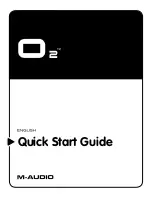
7-12
Setup Mode
The Key/Velocity (KEY-VEL) Page
Velocity Scale (VelScale)
This
lets
you
amplify
or
diminish
velocity
response.
Normal
response
is
100%
.
Higher
values
make
the
keyboard
more
sensitive
(you
don’t
need
to
play
as
hard
to
get
higher
MIDI
velocities)
while
lower
values
make
it
less
sensitive
(playing
harder
doesn’t
change
MIDI
velocity
as
much).
You
can
also
set
the
scale
to
a
negative
number,
in
which
case
the
velocity
response
is
turned
upside
‐
down:
playing
harder
produces
a
softer
sound
and
vice
versa.
This
is
useful
for
creating
velocity
‐
based
crossfades
between
zones.
See
the
following
section
on
Velocity
Offset
for
ideas
about
negative
scaling.
The
following
illustration
shows
what
happens
when
you
change
Velocity
Scale.
Note
that
Velocity
Scale
is
the
only
parameter
changed
in
this
example;
the
other
parameters
are
set
to
their
defaults
(offset
=
0
,
curve
=
linear
,
min
=
1
,
max
=
127
).
MIDI V
e
locity
127
0
127
Strike Velocity
64
64
Velocity Scale: 100%
Velocity Scale: 200%
Velocity Scale: 50%
as you strike the keys harder (increase the
velocity) MIDI velocity increases proportionally
MIDI velocity reaches maximum on
medium strike velocity
MIDI velocity never reaches maximum, even on
maximum strike velocity
Summary of Contents for PC3K6
Page 24: ...1 6 Introduction Options...
Page 50: ...4 4 The Operating Modes Using the Modes...
Page 58: ...5 8 Editing Conventions Special Button Functions...
Page 130: ...6 72 Program Mode Programming Tips...
Page 202: ...7 72 Setup Mode Recording A Setup To Song Mode...
Page 206: ...8 4 Quick Access Mode The QA Editor...
Page 232: ...9 26 Effects Mono Algorithms...
Page 268: ...11 18 Master Mode Preview Sample PRVIEW...
Page 302: ...12 34 Song Mode and the Song Editor Song Editor The EVENT Page...
Page 328: ...14 14 Keymap and Sample Editing Editing Samples...
Page 334: ...B 4...
Page 370: ...D 32 PC3K Objects V 1 31 Effect Chains...
Page 372: ...E 2 PC3K Legacy File Conversion Object Types and Conversion Details...
















































